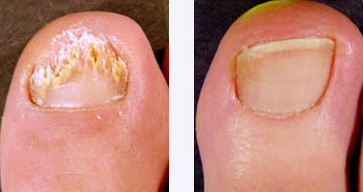PinPointe Laser
The First Laser Treatment for Nail Fungus
The PinPointe Laser is a clinically proven laser device to treat toenail and fingernail fungal infections. We are proud to be the first medical office in Orange County to have this innovative treatment.The First Laser Treatment for Nail Fungus
A Nationally Recognized Leader
Dr. Lorrie Klein’s rare combination of technical expertise and aesthetic sensibility puts her at the forefront of dermatologists nationwide. Dr. Klein’s reputation for providing natural-looking results is why she’s the choice of women and men from throughout Southern California and beyond.

What is the treatment like and do I need to do anything before or after?
- The PinPointe Laser Procedure takes only 20-60 minutes to perform and is usually completely painless.
- No anesthetics or pain medication needed.
- No down time.
- Usually only one treatment is needed.
- We usually recommend treating all 10 nails, even if not all nails appear infected. This is because the other nails often carry the fungus within them and could become infected later. We can however treat just one foot or hand if the other side appears completely normal and you do not wish to prevent infection on the other side.
What can I expect after my treatment?
- After the PinPointe Laser kills the fungus in your nails your new nail growth should grow in normally. Since toenails take 12-18 months to grow out and fingernails 6-9 months, your nails may not look improved until months after your treatment. It could take over a year for your big toenail to look completely normal, less time for other nails. You should see gradual improvement starting at the base of your nails, within 1-3 months.
- Some patients may need a second treatment. If no improvement is seen by 6 months or if nails appear to be worsening, we recommend a second treatment. We discount the second treatment if it is performed within 18 months of your first treatment.
Is there anything I can do to prevent re-infection?
- Throw away old athletic shoes and slippers or wash with bleach in your washing machine. Wipe the inside of your other shoes with a bleach and water solution. Wear flip-flops in the shower and at the gym. Using topical anti-fungal creams and/or powders after your treatment can also help prevent reinfection. UV light disinfecting devices are also available for your shoes at www.sterishoe.com.
- You will receive aftercare instructions that will teach you how to prevent re-infection.
Is there anything I should do prior to my treatment?
- Remove your nail polish and clip your nails down as short as possible before you arrive for your treatment.
- As an option, you may visit a nail technician prior to your laser treatment and ask her to thin your infected nail(s) to a thickness of 1 mm (only the nails that look infected.) This may increase the chance of cure with Pinpointe Laser treatment to 90-95%. Your debrided nails will be very thin however until new nails gradually replace them and they might be sensitive and prone to breaking for many months, due to their thinness.
Before and After
Understanding nail fungus and nail fungus treatments
What are the causes of nail fungus, or Onychomycosis?
Fungi, including yeasts and molds, are typically the causes of nail infections, and most are caused by a group of fungi called dermatophytes. The most common fungi that cause nail infection disease in animals and humans are Trichophyton rubrum, Trichophyton mentagrophytes, and Candida albicans. These fungi can live in the layer of dead skin around your nails, in the space under your nail, and in the nail itself.
What are the signs and symptoms of nail fungus?
Nail infection can cause permanent deformity of the nail, which can interfere with your being able to wear shoes, walking, sports, and other activities. Infected nails often show one or more of the following signs:
- Yellow streaks in the skin under the nail, or nail bed, and on the underside of the nail
- Buildup of bits and pieces of skin and nail fragments under the nail
- Discolored and thickened nail that may separate from the skin under the nail
- Brittle, broken, and thickened nails
- White spots or streaks on the nail surface
- Soft and powdery nail surface, which appear as the infection worsens
- Damaged, crumbly, and brown or gray nail surface, with no separation of the nail from the underlying skin
The PinPointe Nail Laser
The first clinically proven laser device for the treatment of nail fungus.
Stop suffering the pain and embarrassment of unsightly nail fungus. PinPointe Nail Laser is the easy and convenient treatment that helps turn your discolored and disfigured nails into clearer, healthier looking nails.
Safe and effective, this in-office treatment is pain free, has no harmful side effects, and typically takes only about 20 minutes to complete.
The impact of unsightly nail fungus
Nail fungus is a chronic condition that impacts your quality of life and can even lead to serious health problems for patients with diabetes or immune disorders.
The treatment of nail infection is difficult because the infection is under and inside of the nail, which makes it hard for other treatments to reach and destroy the infection. Treatments such as medicated nail polish or oral medications may be associated with side effects or serious drug interactions. Home remedies such as using bleach, vinegar, mouthwash, or household cleaners to resolve the problem are often tried but, ultimately, fail to resolve it.
Talk to us
Give your feet something to smile about from toe to toe. Talk to us about PinPointe FootLaser. Together we can determine if it’s the right treatment for you.

Real Patients. Real Results.
We provide photos of our patients because we think the results speak for themselves. Browse our digital photo gallery of real patients online to discover the possibilities.
Treatment Options
What treatments are available for nail infection?
Nail fungus is an embarrassing chronic condition that impacts your quality of life and can lead to serious health problems for those with diabetes or immune disorders. Nail infection can start as a result of a family history of susceptibility, increasing age, poor health, nail trauma, warm or moist climates, exposure to infected nails in sports fitness and communal bathing areas, and tight shoes.
The treatment of nail infection is difficult because the infection is under and inside the nail, which makes it hard for other treatments to reach and destroy the infection. Treatments such as medicated nail polish or oral medications may be associated with side effects or serious drug interactions. Home remedies such as using bleach, vinegar, mouthwash, or household cleaners to resolve the problem are often tried but, ultimately, fail to resolve it.
Only the PinPointe Nail Laser is designed specifically to treat the major symptoms of discolored and unsightly nails caused by fungus.
Talk to your provider about treatment options currently available for nail infection to determine which is the right treatment for you.
What are the benefits, disadvantages, and risks of treatment?
The benefits, disadvantages, and risks associated with oral and topical drugs and with PinPointe Nail Laser treatment include:
| Treatment | Benefits | Disadvantages/Risks |
|---|---|---|
| Oral Drugs | ||
| Benefits | Disadvantages/Risks | |
| Oral Drugs |
|
|
| Topical Drugs | ||
| Benefits | Disadvantages/Risks | |
| Topical Drugs |
|
|
| PinPointe Nail Laser | ||
| Benefits | Disadvantages/Risks | |
| PinPointe Nail Laser |
|
|
Frequently Asked Questions
Q: How does the PinPointe Nail Laser work?
A: The PinPointe Nail Laser kills fungus that lives in and under the nail. The laser light passes through the nail without causing damage to the nail or the surrounding skin. At the time of the procedure, the toenail will not become instantly clear becuase it takes time to grow out.
Q: What can I expect in the doctor’s office?
A: The process begins with a consultation in which your provider, who will explain the procedure that is to be performed and any follow-up visits that may be required.
Q: Is the procedure painful?
A: Most patients feel no pain. Some may feel a warming sensation. An isolated few may feel a slight pinprick.
Q: Is there a recovery period?
A: No. The treatment is a walk in/walk out procedure.
Q: How long does the procedure take?
A: The PinPointe Nail Laser procedure typically takes about 20 minutes.
Q: Will the fungus grow back?
A: The infection improves after one treatment. However, there is a chance of reinfection because the fungus is present everywhere in the environment. Your will recommend care techniques to help reduce a recurrence of the infection.
Q: When is it safe to paint my nails or have a pedicure following treatment?
A: You can apply polish immediately after the treatment. It is important that you remove all nail polish and nail decorations the day before your treatment.
Q: How do I pay for the procedure?
A: Credit cards, cash, and checks are accepted.
Q: Is the procedure covered by insurance?
A: This procedure is considered aesthetic and therefore health insurance does not provide coverage. However you can use your HSA, Medical IRA, or Flexible Spending Account can be used to cover this procedure.
Q: How long has the PinPointe Nail Laser been in use?
A: Clinical studies began in November 2007.
Q: Is the PinPointe Nail Laser FDA cleared?
A: Yes, the device has received FDA clearance.
Q: Who developed the PinPointe Nail Laser procedure?
A: Leading scientists and medical professionals working together for 20 years with funding provided by the National Institutes of Health developed the technology used in the patented PinPointe Nail Laser.



